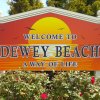Rehoboth to begin stormwater testing
Rehoboth Beach is sampling stormwater sampling near Lake Gerar and the Boardwalk to determine the sources of bacteria that flow into the ocean through the city’s stormwater outfalls.
The sampling is required by Delaware Department of Natural Resources and Environmental Control when it approved Rehoboth’s ocean outfall permits. Nine water quality samplers will be installed next to manholes to examine what is in the water flowing to stormwater outfalls on Maryland, Rehoboth and Delaware avenues as well as Grenoble Place and Laurel Street.
The information will be used to develop options to reduce stormwater volume, evaluate disposal options and improving water quality, city spokeswoman Krys Johnson said. International engineering firm GHD are managing the project. Sample collectors will be visible by their GHD safety vests, Johnson said.
Johnson said during a storm, samples will be collected at specific times, and the units should not be unplugged, moved or disturbed to ensure the collection of accurate data. She said if a unit looks to have been tampered with, contact the Rehoboth Beach Police Department at 227-2577 so the unit can be checked.
Mayor Sam Cooper said the $250,000 project is the second step in determining a path forward in how the city can reduce stormwater pollution. The first step was a report by GHD that identified enterococcus as the main bacteria found in the waters around Rehoboth’s stormwater outfalls. Enterococcus is found in the guts of all warm-blooded animals.
In June 2016, elevated levels of enterococcus bacteria led to a water advisory for the area between Baltimore Avenue and Norfolk Street. DNREC said rainfall caused waste from birds, marine mammals or domestic pets to go into the ocean. No human waste was detected, the department said.
GHD’s report assumes high concentrations of enterococcus found in the ocean off Rehoboth are a direct result of stormwater runoff, but its exact source has not been identified.
While sampling is done twice a week during the summer, the report said testing has not been detailed enough to show the sources of enterococcus or the effects of rainfall.
GHD's report identifies a number of hotspots for potential pollution including seagull feces on the Boardwalk and nearby streets, dog feces on residential properties, the Boardwalk foot showers, trash pickup locations on the streets, and waterfowl feces in Silver Lake and Lake Gerar, which empty into the ocean.
However, the report said without detailed sampling, it is difficult to identify the impact of these sources.
“What we didn’t have was good data on what’s in the water,” Cooper said. “Now what we need is a good rain event to get samples.”
As for what will happen in future, Commissioner Paul Kuhns said, “It’s not a cheap project. It’s a huge problem because of everything that runs out into the ocean and out into the lakes. We should be setting aside $1 million a year specifically for stormwater outfall.”
For questions about sampling, contact Jeff Riling of GHD at 240-206-6838 or at jeff.riling@ghd.com.
Ryan Mavity covers Milton and the court system. He is married to Rachel Swick Mavity and has two kids, Alex and Jane. Ryan started with the Cape Gazette all the way back in February 2007, previously covering the City of Rehoboth Beach. A native of Easton, Md. and graduate of Towson University, Ryan enjoys watching the Baltimore Ravens, Washington Capitals and Baltimore Orioles in his spare time.
























































